L'eredità culturale della Scuola Medica Padovana
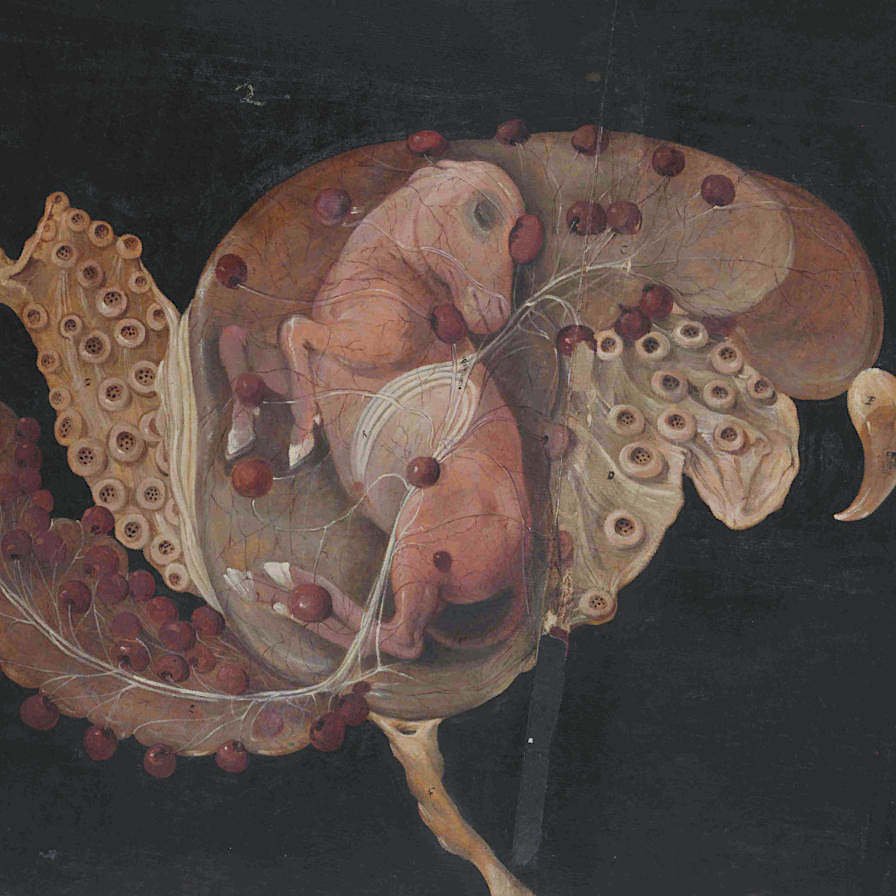
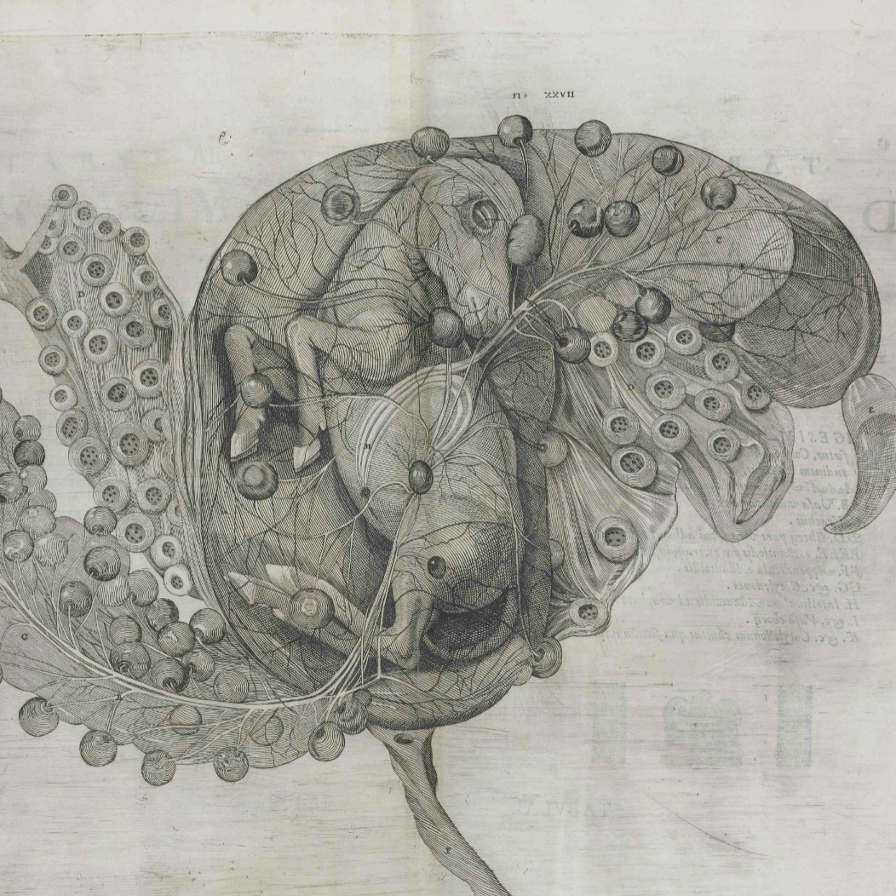
Dalle tavole di anatomia comparata "De formato foetu" di Fabrizio d'Acquapendente. Confronto tra la tavola disegnata e colorata a mano e l'incisione della versione a stampa (Biblioteca Marciana).
Testi significativi dal XIII al XVII secolo
La collezione digitale "L'eredità culturale della Scuola Medica Padovana" è iniziata nell'anno accademico 2014–15 in coincidenza con il 500esimo anniversario della nascita di Andrea Vesalio (1514–1564) il docente della Scuola Medica dell'Università di Padova che nel 1543, con la pubblicazione del trattato De humani corporis fabrica, ha rivoluzionato l'arte medica attuandone il passaggio dalla medicina medioevale a quella dell'età moderna.
L'immediata enorme risonanza del trattato nella comunità internazionale delle Scuole Mediche portò all'abbandono dell'approccio medico-scientifico basato sulle teorie scritte dei classici. Vesalio è "l'autore" di questo nuovo paradigma fondato sul modello dell'approccio sperimentale. Con lui diviene centrale la disciplina, fino a quel tempo negletta, dell'Anatomia.
Sul modello sperimentale si era mossa con gli atti e le opere la Scuola Medica Padovana nei tre secoli di vita dalla fondazione, acquisendo la risonanza che nel 1537 richiama Vesalio a Padova dalla Scuola Medica di Parigi.
Nel Gymnasium patavinum (fondato nel 1222) l'insegnamento della medicina sorge intorno al 1250, con l'istituzione del Collegio dei Dottori Medici e Artisti. Sin dagli inizi l'ambiente culturale è connotato da un forte indirizzo naturalistico, con il sostegno del libero Comune (secolo XIII), della Signoria dei Carraresi (secolo XIV) e, in seguito, dal 1404, della Serenissima Repubblica di Venezia il cui patrocinio difende lo sviluppo di una scienza basata sulla comprensione e valutazione delle evidenze oggettive, in grado di affrancarsi da imposizioni sia dottrinali sia ecclesiastiche.
Agli inizi del XIV secolo la figura del medico si va caratterizzando come "philosophus naturae".
Protagonista di questo orientamento è Pietro d'Abano che insegna medicina a Padova dal 1307 al 1313 lasciando un'impronta indelebile alla Scuola Medica. Personaggio di straordinaria cultura, vive un lungo periodo a Costantinopoli per apprendere il greco e l'arabo. Studioso dei testi originali in arabo di Avicenna e Averroè, è il primo traduttore in latino, dal greco, di molta parte delle opere di Galeno. Nel Conciliator si propone di conciliare le differenze tra i filosofi, ossia Aristotele e soprattutto i suoi commentatori, e i medici, cioè Ippocrate, Galeno e i medici arabi sul tema se la medicina possa essere considerata una scienza ("utrum medicina sit scientia, necne") e definisce la medicina come scienza che ha le sue basi "nel fare per mezzo di esperimenti".
Pietro è un potente innovatore poiché afferma per il medico la centralità dell'esperienza diretta "l'arte medica non deve considerare che quelle cose che si possono vedere o sentire" ed è l'autore della prima autopsia di cui si abbia notizia a Padova. Accusato ripetutamente di eresia, muore in carcere. Riconosciuto come "maestro" i successori raccolgono e sviluppano la sua lezione per tutto il '300 e il '400. Da queste premesse la Scuola Medica cresce nella direzione della scienza sperimentale e diviene autorevole.
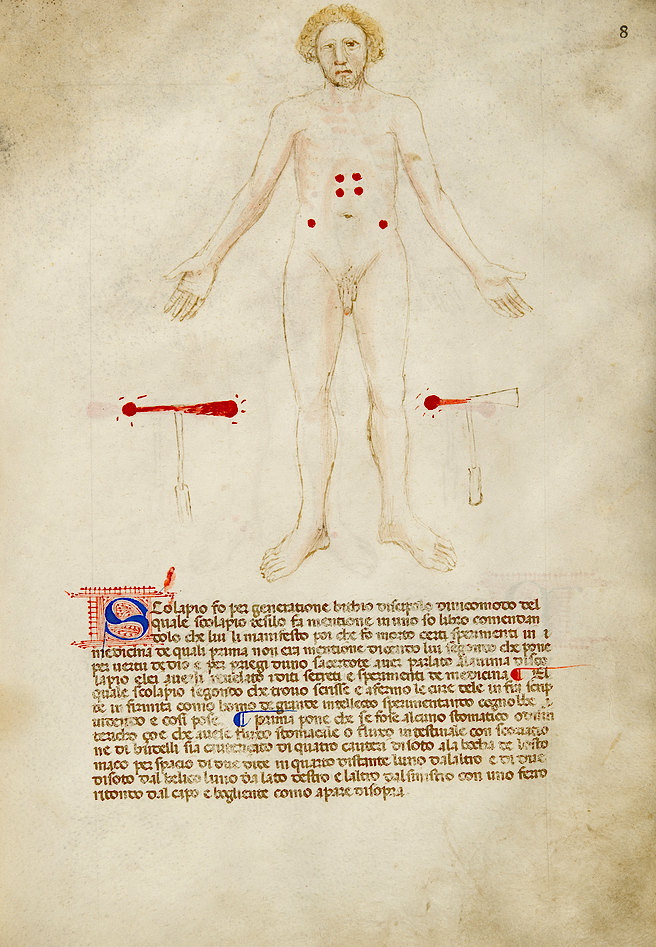 Una pagina del "De cauteriis" ("Libro de le experiençe che fa el cauterio del fuocho ne corpi humani") (da Phaidra)
Una pagina del "De cauteriis" ("Libro de le experiençe che fa el cauterio del fuocho ne corpi humani") (da Phaidra)
Tra le numerose testimonianze di innovazione si pensi alla realizzazione in Padova del codice "De cauteriis" ("Libro de le experiençe che fa el cauterio del fuocho ne corpi humani"), della fine del XIV secolo. Tra gli eventi indicativi del credito di cui godeva la Scuola è il fatto che Galeazzo dei Santa Sofia, docente padovano, viene chiamato da Padova a Vienna dove insegna dal 1398 al 1406, e lì vi compie, nel 1404 la prima dissezione pubblica mai tenuta a Vienna.
• La Practica maior di Michele Savonarola in Internet Archive
• I Consilia di Bartolomeo Montagnana in Internet Archive
• I Consilia di Antonio Cermisone in Google Libri
A metà del 400 la dissezione è attività continua in Padova e porta alla nascita della scuola anatomica. Si osserva inoltre la produzione di opere che sono espressione di un intenso e raffinato esercizio dell'arte medica, tra queste la Practica maior (Practica de egritudinibus a capite usque ad pedes) di Michele Savonarola (1385–1466), continuatore di Pietro d'Abano, e i due "Consilia" di Bartolomeo Montagnana e di Antonio Cermisone, ambedue comparsi nel 1476.
Alla fine del XV secolo l'innovazione della stampa, con Venezia centro di assoluta importanza per questa nuova attività, porta ad una accelerazione nella condivisione dei saperi. Il Fascicolo di Medicina di Pietro da Montagnana, opera curata da Johannes Ketham, stampata a Venezia dai fratelli Giovanni e Gregorio De Gregori, in latino nel 1491 e in volgare nel 1494, raggruppa i testi valutati necessari per lo studio e la pratica dell'Arte Medica, ed è considerato come un "libro di testo".
• "Historia corporis humani siue anatomice" in Internet Culturale (Biblioteca Marciana)
Degli inizi del XVI secolo, stampata a Venezia nel 1502 da Bernardino Guerralda da Vercelli, è l'opera di Alessandro Benedetti "Historia corporis humani siue anatomice". Il trattato è il primo che definisca anche necessità e norme per la costruzione e organizzazione di un teatro anatomico. Quest'opera fa parte di una ampia produzione che attesta l'importanza dell'arte della dissezione anatomica nella Scuola Medica Padovana, ricca di un sapere innovativo e condiviso, basata su di una conoscenza alimentata da teoria e pratica a differenza delle maggiori scuole mediche europee dove l'approccio sperimentale era ancillare alla tradizione scritta e poco accolto.
È per entrare in questo ambiente che Andrea Vesalio abbandona la Scuola Medica di Parigi, scegliendo di laurearsi in medicina a Padova e farvi ricerca. Giunto a Padova nell'autunno del 1537 Vesalio consegue il dottorato in medicina il 5 dicembre e immediatamente viene incaricato dell'insegnamento della Chirurgia, con l'espressa condizione "che dovesse leggere anatomia e praticar dissezioni".
Alle sue lezioni partecipa un vasto pubblico, studenti di medicina, medici, letterati e uomini illustri e nel 1538, a seguito delle loro richieste Vesalio prepara e pubblica le Tabulae Anatomicae sex. Il volume fu stampato a Venezia da Bernardino Vitali nel 1538 e le tavole erano in parte disegnate da Vesalio in parte dal pittore fiammingo, allievo di Tiziano, Jan Stephan van Calcar. Poi, con il supporto di van Calcar e con un imponente lavoro durato sino al luglio del 1542 produce il trattato rivoluzionario: i sette libri della "Fabrica" ("Andreae Vesalii Bruxellensis, scholae medicorum Patauinae professoris, de Humani corporis fabrica Libri septem") e un sunto dell'opera, ad uso pratico e degli studenti l'"Epitome" ("Andreae Vesalii Bruxellensis, scholae medicorum Patauinae professoris, suorum de Humani corporis fabrica librorum epitome") ambedue le opere vengono date alle stampe contemporaneamente, nel giugno 1543. La potenza dell'opera grande, che Vesalio mostra prima della stampa a Giovan Battista Canani (1515–1579), docente di Anatomia a Ferrara, impressiona talmente Canani da indurlo a desistere dal suo progetto di un trattato di Anatomia in sei libri, del quale aveva pubblicato nel 1541 il primo volume "Musculorum humanis corporis picturata dissectio". A Vesalio Canani comunica la sua scoperta delle valvole delle vene ciò che verrà ripreso in seguito da Fabrizio d'Acquapendente.
Contestualmente alla pubblicazione delle due opere ("Fabrica" ed "Epitome") Vesalio lascia l'Università, l'insegnamento e la ricerca e diviene il medico dell'Imperatore Carlo V.
"De humani corporis fabrica libri septem di Andrea Vesalio (1543)". Video a cura di Maurizio Rippa Bonati, Giulia Rigoni Savioli, Lorisa Andreoli e Laura Tallandini.
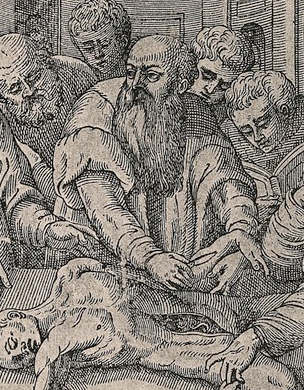
Realdo Colombo mentre esegue un'autopsia nel frontespizio del "De re anatomica" (da Wellcome Collection. CC BY)
• "De re anatomica" in Gallica
La "Fabrica" ponendo al centro dello studio e dello sviluppo della medicina la conoscenza sperimentale dell'Anatomia, segna un passaggio epocale e Padova, centro della disciplina dell'Anatomia, è Scuola Medica di straordinaria importanza e tale resta, nel secolo e a cavallo del Seicento, grazie agli eccellenti successori: Realdo Colombo, Gabriele Falloppio, Fabrizio d'Acquapendente e Giulio Casseri. Dalla pubblicazione della "Fabrica" nel 1543 inizia il così detto "secolo d'oro" della Scuola Medica dell'Università di Padova.
A Realdo Colombo (1510–1559), il primo a succedere a Vesalio, docente a Padova dal 1543 al 1545, dobbiamo la prima descrizione della circolazione polmonare (o piccola circolazione: per la prima volta viene razionalizzato e descritto il viaggio del sangue venoso dal cuore ai polmoni dove viene mescolato con l'aria e poi torna al cuore) e l'osservazione totalmente innovativa che l'azione principale del cuore sia la contrazione ("De re anatomica", 1559). Ambedue questi aspetti vengono poi ripresi da Harvey e inscritti nel suo modello di circolazione del sangue.
A Realdo Colombo succede Gabriele Falloppio (1523–1562) che ancora richiama quale primo fondamento della conoscenza l'osservazione diretta ("quoniam ex sensu hoc est cognoscendum, non autem ex ratione"). Di vasti interessi scientifici, che comprendono anche la conoscenza dei Semplici, Docente di Anatomia seguitissimo, i suoi lavori investono a 360° l'Anatomia Umana ("Observationes anatomicae", Venezia 1561) e Comparata e verranno ripetutamente e in varie forme stampati postumi durante tutto il XVI secolo e nel successivo, a Venezia, Padova, Norimberga, Francoforte, costituendo testi di riferimento per generazioni di medici non solo per l'Anatomia, ma, più in generale, per la Medicina e le sue applicazioni.
A Falloppio succede Fabrizio d'Acquapendente (1537–1619) che con la sua cinquantennale docenza dà vita ad una scuola di famosi medici e anatomisti tra cui il più celebre è William Harvey (1578–1657).
Della produzione monumentale di Fabrizio va ricordato innanzi tutto il trattato De venarum ostiolis del 1603 nel quale disegna per la prima volta le valvole semilunari delle vene; le sue illustrazioni vengono riprodotte poi dall'ex allievo Harvey nell'opera che risolve il problema della circolazione sanguigna ("Exercitatio anatomica de motu cordis et sanguinis in animalibus", Francoforte 1628).
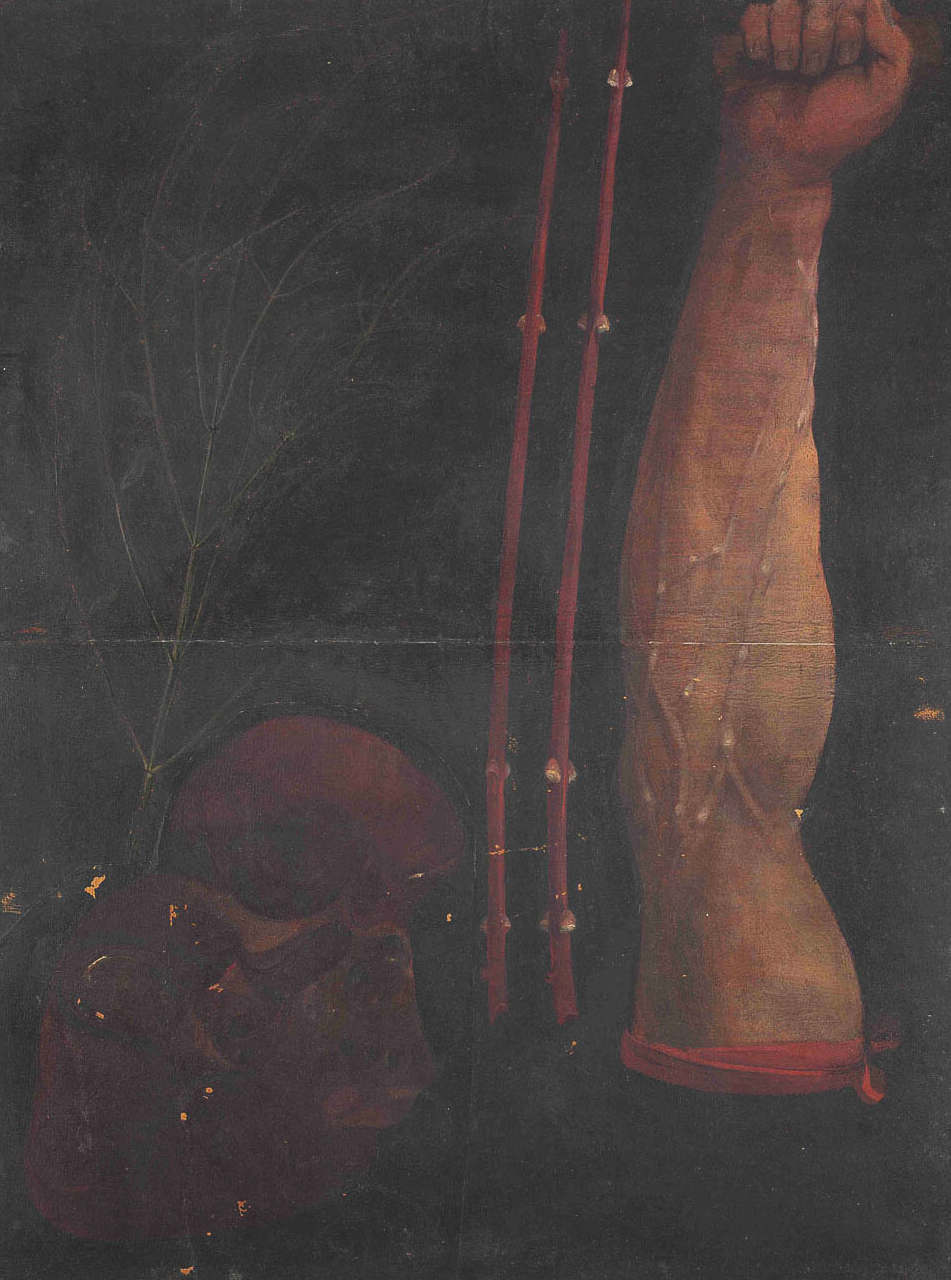 Una tavola dal De venarum ostiolis di Fabrizio d'Acquapendente (da Phaidra)
Una tavola dal De venarum ostiolis di Fabrizio d'Acquapendente (da Phaidra)
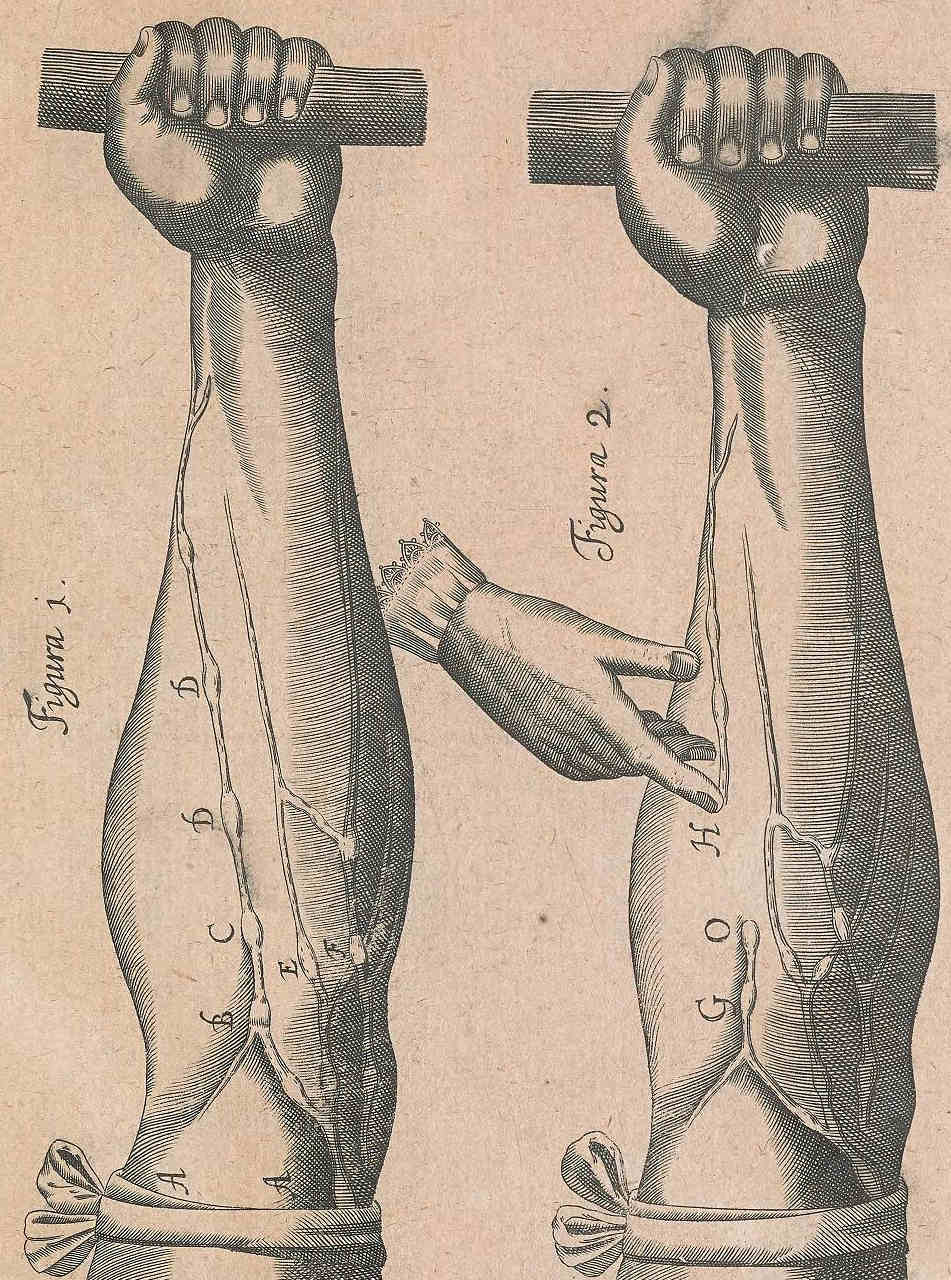 Una pagina da "Exercitatio anatomica de motu cordis et sanguinis in animalibus" di William Harvey (da Internet Archive)
Una pagina da "Exercitatio anatomica de motu cordis et sanguinis in animalibus" di William Harvey (da Internet Archive)
Come già riportato per Falloppio, anche sulle opere di Fabrizio, in particolare le Operationes chirurgicae, una summa di tutta la scienza chirurgica dell'epoca, pubblicate per la prima volta in Padova nel 1617 e poi in numerosissime edizioni nel corso dei secoli XVII e XVIII in Italia e in Europa, in traduzione italiana e francese, si formarono intere generazioni di medici europei.
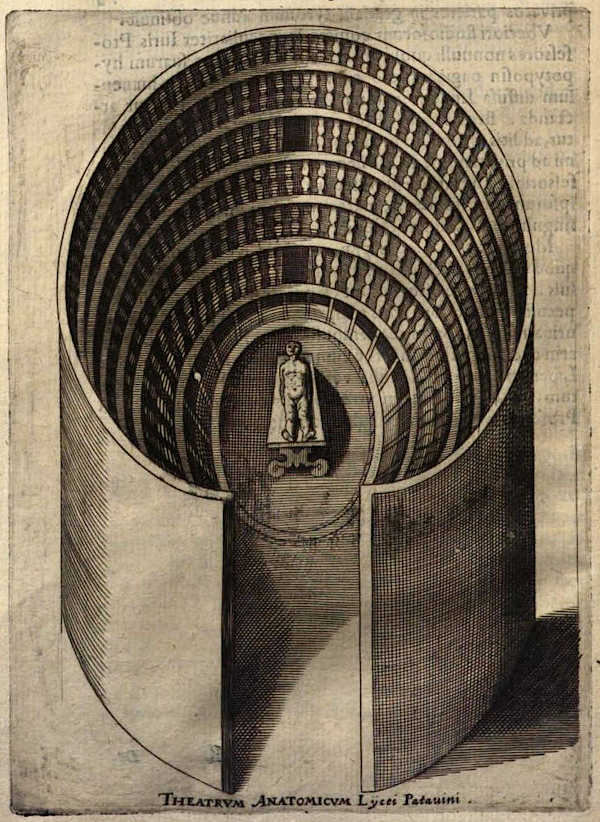 Il teatro anatomico patavino in un disegno del 1654 (da "Gymnasium Patavinum Iacobi Philippi Tomasini episcopi Æmoniensis libris 5...", Internet Archive)
Il teatro anatomico patavino in un disegno del 1654 (da "Gymnasium Patavinum Iacobi Philippi Tomasini episcopi Æmoniensis libris 5...", Internet Archive)
A conferma dell'importanza primaria dell'Anatomia Umana, Fabrizio cura la realizzazione presso il Bo, nel 1595, del I° teatro Anatomico stabile al mondo, seguendo le norme costruttive e dell'organizzazione indicate un secolo prima da Alessandro Benedetti e lascia per testamento alla Biblioteca Marciana le sue "Tavole di Anatomia" disegnate e colorate a mano, sia come segno di riconoscenza verso la Repubblica di Venezia per la politica di sostegno alla scienza, sia perché fossero apertamente disponibili per quanti potevano accedere alla Pubblica Biblioteca.

Giulio Cesare Casseri (da Wellcome Collection. CC BY)
• Il Pentaestheseion in una digitalizzazione della Biblioteca Nazionale Centrale di Firenze
A Fabrizio succede Giulio Cesare Casseri (1552–1616), inizialmente suo "cliens et domesticus famulus" e suo allievo, con cui ebbe poi un rapporto conflittuale. Di lui restano fondamentali gli studi sui 5 organi di senso riportati nell'opera "Pentaestheseion, hoc est de quinque sensibus liber, organorum fabricam, actionem et usum continens", stampata a Venezia nel 1609 e nel 1627 e a Francoforte nel 1609, 1610, 1612, 1622, 1632, divisa in cinque libri, uno per ciascuno dei sensi e le "Tabulae anatomicae LXXVIII cum supplemento XX tabularum D. Bucretii", stampate a Venezia nel 1627, a Francoforte nel 1632, e ad Amsterdam nel 1645, di cui una prima stampa, quasi un pre-print, è: "Iulii Casserii Tabulae Anatomicae quarum aliquot explicationes sua ipsa manu adscripsit necdum editas".
Così, con lasciti di arte medica che costituiranno base di riferimento per i successivi due secoli i protagonisti post-vesaliani, che hanno studiato gli antichi scienziati, hanno fatto tesoro dei saperi dei loro predecessori, hanno praticato la scienza sperimentale e la descrivono in latino, la lingua scritta degli studiosi, fanno vivere il secolo d'oro della Scuola di Anatomia.
Ed è a questa Scuola, cioè all'ambiente in cui si realizza un sapere di sfondo innovativo, coscientemente affrancato da imposizioni dottrinali e religiose, che viene universalmente riconosciuto il merito di aver dato luogo ad una rivoluzione culturale nell'approccio medico, passaggio necessario per lo sviluppo della medicina moderna.
La presente collezione digitale è resa possibile dalla collaborazione di: Università di Padova (Centro di Ateneo per le Biblioteche, Centro per la Storia dell'Università, Biblioteca medica 'V.Pinali' antica), Biblioteca Universitaria di Padova (MiBAC), Biblioteca Nazionale Marciana di Venezia (MiBAC).
La collezione potrà arricchirsi di altri testi in concomitanza con lo sviluppo di nuove digitalizzazioni.

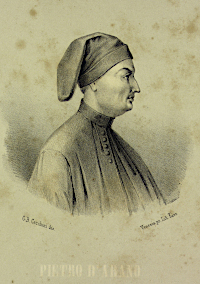
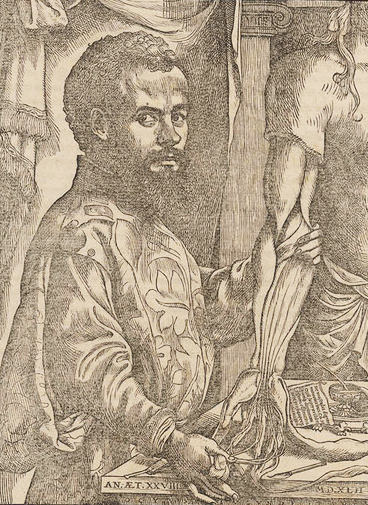
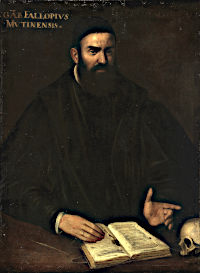



 è un servizio del
è un servizio del